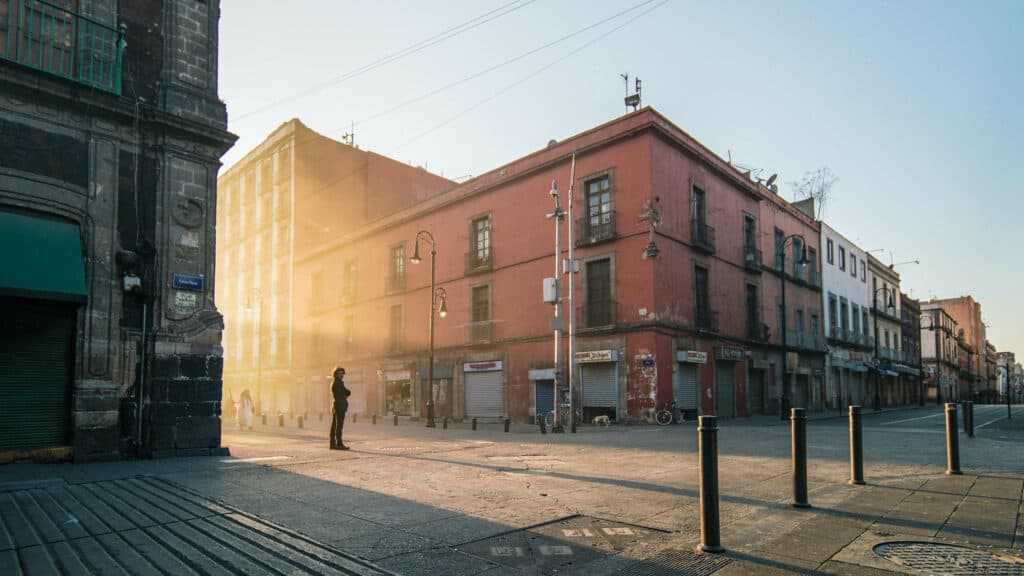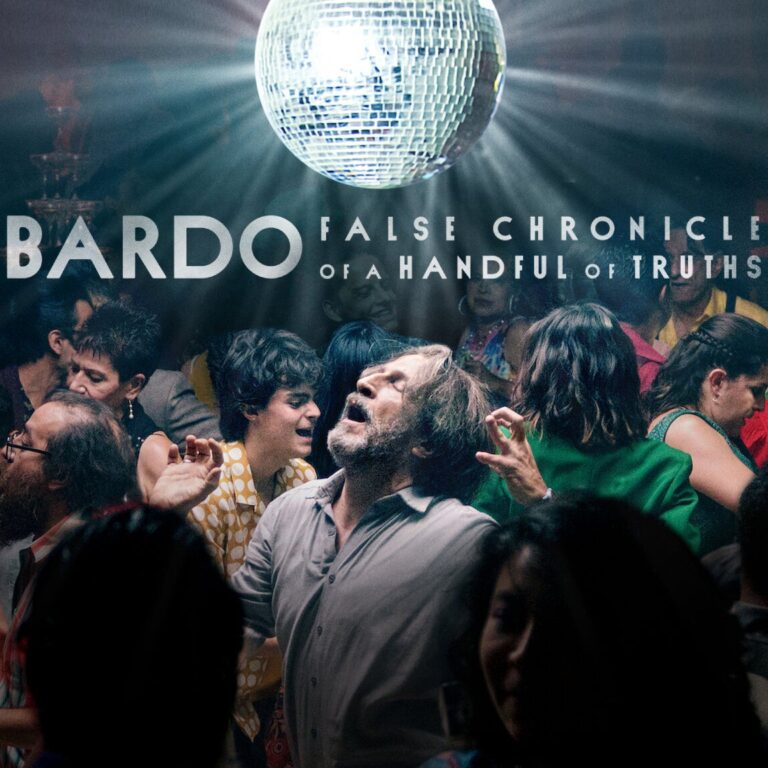Bardo: False Chronicle of a Handful of Truths – Snapshot
Bardo: False Chronicle of a Handful of Truths is an extremely complex and personal expression of a man experiencing multiple transitions in his life. This film is definitely not for everyone, but if you want an immersive film experience, give it a go! (3.5*)
Where to Watch:
Stream: Netflix
Rent: (Nowhere I Could Find)
Bardo: False Chronicle of a Handful of Truths – The Oscar Buzz
Oscar Nominations:
Cinematography (Darius Khondji)
Bardo: False Chronicle of a Handful of Truths owes its visual appeal to Iranian-born Darius Khondji. Khondji uses lenses that give a sharp fidelity to the center part of the image but you will notice the left and right edges tend to add subtle distortion. I’m guessing that is intentional to reinforce the pervasive influence of transitions (see the Special Mention section). He also often uses wide panoramic views as transitions between scenes. His framing is spot on and sometimes reminds me of a Wes Anderson movie. Inarritu presented multiple challenges to Khondji who met them with visual dare. Khondji was previously nominated for his work in Evita (96).
Other prior year nominees and winners involved in Bardo include.
Director (Inarritu): The Revenant (WINNER) / Babel / Birdman or (The Unexpected Virtue of Ignorance) (WINNER)
Writer (Inarritu/Giacobone) : Birdman or (The Unexpected Virtue of Ignorance) (WINNER)
Production Design (Caballero): Roma / Pan’s Labyrinth (WINNER)
Bardo: False Chronicle of a Handful of Truths – The Movie’s Family Tree
The Following Movies Share Talent with This One
(and if you like these films, you might like this one):
21 Grams (03) : Director (Inarritu)
Biutiful (10) : Director (Inarritu); Writers (Inarritu/Giacobone)
Cyrano (21) / The Two Popes (19) : Composer (Dessner)
Bardo: False Chronicle of a Handful of Truths is viewed by its creator, Alejandro Inarritu, as his most complicated movie ever and, possibly, his life’s grand opus. Referring to Bardo, Inarritu said “the problem with this film is that all of the fabric of this film is made of elusive emotions, and feelings, and dreams and things, but those things are immaterial, there is no recipe. Then to turn them into an idea, and then to write them, and to convert a sequence, and give a reason, and then execute them and flesh them out is super difficult.” I learned in my research that Bardo consists of 32 unique sequences which, essentially stand alone. There is no continuous thread through this movie and in fact, you could conceivably start the film with any one of them and proceed in a more or less random order.
Inarritu is one of the Three Amigos of the Mexican film industry along with Alfonso Cuaron and Guillermo del Toro. All three of them have received substantial recognition across the U.S. border and they film in both countries. After more than 20 years working in California, Inarritu returned to his native Mexico to make Bardo, which is done, mostly, in Spanish, filmed primarily in Mexico City and Cabo San Lucas (in Baja del Sur), and employs a Latin crew and cast.
I loved Cuaron’s Roma, but earlier this year I panned del Toro’s animated film Pinocchio as an exercise in self indulgence. And you could make similar comments about Inarritu’s Bardo. But Bardo is a fascinating and deeply complex dive into film structure and design and is a commendable attempt to bring the surrealism of dreams to the cinema screen.
Bardo: False Chronicle of a Handful of Truths – What Others Think
When we get down to the tail end of the Oscar list, most of the films haven’t been rated, or reviewed, by very many people. In the case of Bardo: False Chronicle of a Handful of Truths, audience ratings number less than 15K, which is a pretty paltry audience. At 2 hours and 39 minutes in length and with no obvious structure to a film with 32 different sequences, this is a challenging film to watch. It isn’t surprising, then, that audience ratings place this movie 22nd, out of 25 general interest films, tied with Causeway.
Critics agreed with audiences, and often for similar reasons. Neil Minow (RogerEbert) seems to agree with Inarritu’s essential message that “Reality is much too big, complex and uncontainable to contain completely…” and finds Bardo’s story to be “told in a subjective fanciful fashion.” John Bleasdale (Sight&Sound) writes “Bardo is a technical marvel – but its constant stream of ideas is an attempt to hide the fact that it has nothing much to say.” And closes with a slam “It is a gloriously rendered fantasy; a gold plated opportunity to gaze at a filmmaker’s navel.” A.O. Scott (New York Times) agrees with that premise, but not his conclusion: “Proudly and self-evidently the product of a monumental ego. Inarritu isn’t always the clearest or most cogent thinker, but the power of his images often renders such objections moot.”
Bardo: False Chronicle of a Handful of Truths – Special Mention
“Bardo” – is a Buddhist term that refers, in its purest meaning, to the transition state between death and reincarnation. Not being an expert, by any means, in Buddhism, I did some research and learned that the term has, like many religious terms, a much broader meaning. “Bardo” has come to mean pretty much any “intermediate state” or time of transition. In an excellent article describing the state and why it is important to Buddhist thought, Peña Khandro Rinpoche says “It also refers more generally to those moments when gaps appear interrupting the continuity that we otherwise project onto our lives…to be precise, bardo refers to that state in which we have lost our old reality and it is no longer available to us.” (Article in LionsRoar.com )
The film Bardo is, in fact, all about transitions. And the film makes much more sense if you view it from that perspective. Be mindful, though, that transitions aren’t just in time, they can also be between locations, people, situations, history, dreams…. I suspect it could be argued that all of experience is one continuous stream of bardo states and, actually Silverio, the main character, at one point says “After everything I’ve gone through, I just have to accept that I am the Bardo.” I could list all of the “bardos ” I saw in the movie, but I think that would detract from your own discovery – you will get the most pleasure from this film if you enjoy each scene separately as an example of Bardo.
(As an aside, the other part of the title, “False Chronicle of a Handful of Truths”, is clarified at one point in the film, as the title of the documentary that Silverio has just completed and is the trigger for all the other transitions in the movie.”)
Bardo: False Chronicle of a Handful of Truths – Michael’s Moments
Bardo: False Chronicle of a Handful of Truths is an exceedingly complex movie and will likely not be enjoyed with a casual viewing. After my first viewing, I felt like I had just completed a mindless exercise mixing Fellini with Salvador Dali. Approaching three hours, this film will tax the patience of most viewers, and for good reason. Simply put, this isn’t a movie for mass consumption – it is about as far away from a Marvel block-buster as you can get.
I’m not sure Inarritu intended it to be any different. As noted in a quote from him above, this is the most complicated film he’s ever designed and the most difficult one for him to make. As some of the critics have noted, Inarritu is clearly exposing his navel for the world to see. There are several scenes related to a baby that was never born – a soul that couldn’t exit the Bardo state. It turns out that Inarritu, and his wife, suffered a loss of a newborn. Silverio, in the movie, is transitioning to internationally recognized status as a documentary filmmaker, much as Inarritu has achieved worldwide acclamation, especially with his Birdman… movie. (BTW, Birdman… also had strong Buddhist elements!). Reportedly at least, Inarritu’s wife was told she ‘cannot call the U.S. her home’ by an ICE agent, mirroring an important scene in the movie and reflecting another difficult transition. So Bardo is, in many ways, a reflection of Inarritu’s biography.
If that’s all it was, then I’m not sure I’d care. But I think this movie goes far beyond just being casual navel gazing. With 32 different sequences which can be viewed in any order, I have to believe that he has a grander intellectual structure in play that is infused with his personal life, but is also an exercise in precise filmmaking, with great staging, cinematography, and, of course, transitions. I wouldn’t be surprised if there was a class at USC film school dedicated to understanding this movie.
But I, for one, do not have the time to fully understand this film. And neither will most of the viewing public. So, how do I rate this film? And should the reader of this review watch it? Very tough questions. If you have the time and the desire to explore a complex movie with multiple and often confusing emotional layers, then you should give Bardo at least one viewing. If you like your movies in concise, understandable packages, then give it a pass. Just because I think some people will enjoy this film, I’m going to give it my minimum recommended rating: (3.5*)


